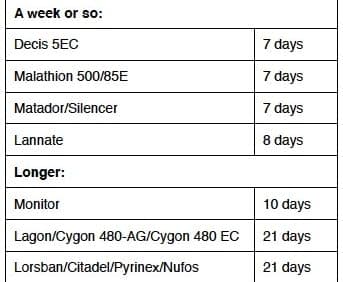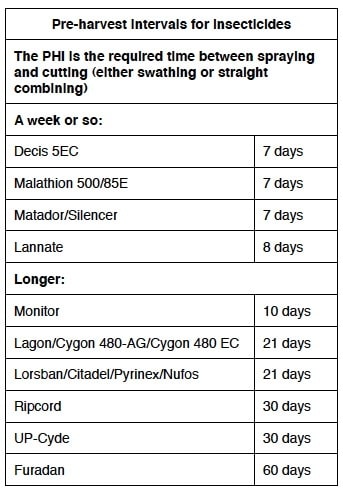Many canola crops are maturing earlier than expected this year, in many cases due to hot weather. This has put some growers in a bind. They had sprayed insecticide expecting to be outside the pre-harvest interval (PHI) required between application and the planned cutting date, but now as the crop approaches swathing timing they realize that not enough time has passed. It is important that growers follow the PHI for all products, otherwise harvested seed could exceed pesticide residue limits for key markets. Samples from all grower deliveries are saved, so any infraction can be traced back.
So what to do?
Delay swathing until the PHI has passed. Late swathing can actually improve yield, as Canola Council of Canada research has shown. While the current recommendation is up to 60% seed colour change, treatments in our past trials swathed at 60-70% SCC produced only minor yield reductions compared to 50-60% SCC and still outperformed swathing at 30-40%. This is a good option to consider if a few days will get you outside the PHI and help avoid potential residue issues. Swath in the dew and avoid excessive roller pressure to minimize shattering of ripest plants in these situations.
Straight combine the crop. “Cutting” for the purpose of PHI can be swathing or straight combining. Straight combining will increase the risk of shattering losses, especially when thin crops whip in the wind. However, most trials have shown straight combining canola tends to yield nearly as well as swathing, except in cases where extreme weather occurs when the crop is nearly ripe enough to combine. For fields with a later application of insecticide that need more than a couple of extra days to stay outside the PHI window straight combining may be the best option. Click here for an article from last week with tips for maximizing success with straight cutting.
Swath just ahead of the combine. Straight combining is preferred over this technique, but for growers not equipped or not comfortable with straight combining canola, this can work. The extra step of swathing such a ripe field will increase shattering losses, but these losses can be reduced by swathing early in the morning or at night when plants are covered in dew, are tougher, and therefore less likely to shatter. Matching reel speed to travel speed and reeling as little as possible, and setting the opening as wide as possible to avoid bunching of the fluffy swath as it moves through may help reduce shattering. Avoid rolling in this situation as it will significantly increase shattering, but be prepared to harvest the swaths as soon as they are dry enough as they will be very susceptible to flipping in the wind.

